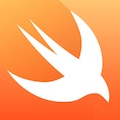Using the Yoctopuce library with Swift
 Last year, Apple presented its new programming language for iOS and OSX: Swift. This language is easier to use (and to learn) than Objective-C and its syntax is radically different. To ensure a smooth transition to this new language, you can create "hybrid" applications which have a part written in Swift and a part written in Objective-C. Theoretically, our Objective-C library should work as-is in a Swift project. In practice, it's somewhat more complex...
Last year, Apple presented its new programming language for iOS and OSX: Swift. This language is easier to use (and to learn) than Objective-C and its syntax is radically different. To ensure a smooth transition to this new language, you can create "hybrid" applications which have a part written in Swift and a part written in Objective-C. Theoretically, our Objective-C library should work as-is in a Swift project. In practice, it's somewhat more complex...
| No comment yet | Read more... |
How to secure the HTTP Callback mode
 This week, we are going to talk about the HTTP Callback mode. More particularly, how to authenticate a YoctoHub and to make sure that an intruder can't insert invalid data in your system.
This week, we are going to talk about the HTTP Callback mode. More particularly, how to authenticate a YoctoHub and to make sure that an intruder can't insert invalid data in your system.
| No comment yet | Read more... |
New Excel plug-in
![]() Some time ago we showed you how to efficiently read Yoctopuce sensors from Excel, using an RTD server written in C# .NET. As this solution works quite well, we have been asked whether it was possible to extend our sample code to handle other Yoctopuce devices. It's Christmas time, here you are :-)
Some time ago we showed you how to efficiently read Yoctopuce sensors from Excel, using an RTD server written in C# .NET. As this solution works quite well, we have been asked whether it was possible to extend our sample code to handle other Yoctopuce devices. It's Christmas time, here you are :-)
| No comment yet | Read more... |
Interfacing a rotary encoder with a Yocto-Knob
 We already used the Yocto-Knob to interface potentiometers, buttons, photo-diodes, but never so far a rotary encoder. This week, we are going to see how to interface a rotary encoder with a Yocto-Knob to create a more advanced human-computer interface.
We already used the Yocto-Knob to interface potentiometers, buttons, photo-diodes, but never so far a rotary encoder. This week, we are going to see how to interface a rotary encoder with a Yocto-Knob to create a more advanced human-computer interface.
| 5 comments | Read more... |
New tools to update your modules
 Until now, the only way to update a Yoctopuce module was to use the VirtualHub. Since version 18640 of our libraries, you can update your module firmware with the Yoctopuce libraries. We also published an Android application enabling you to update your modules. Let's have a look at these new ways of updating.
Until now, the only way to update a Yoctopuce module was to use the VirtualHub. Since version 18640 of our libraries, you can update your module firmware with the Yoctopuce libraries. We also published an Android application enabling you to update your modules. Let's have a look at these new ways of updating.
| 3 comments | Read more... |


